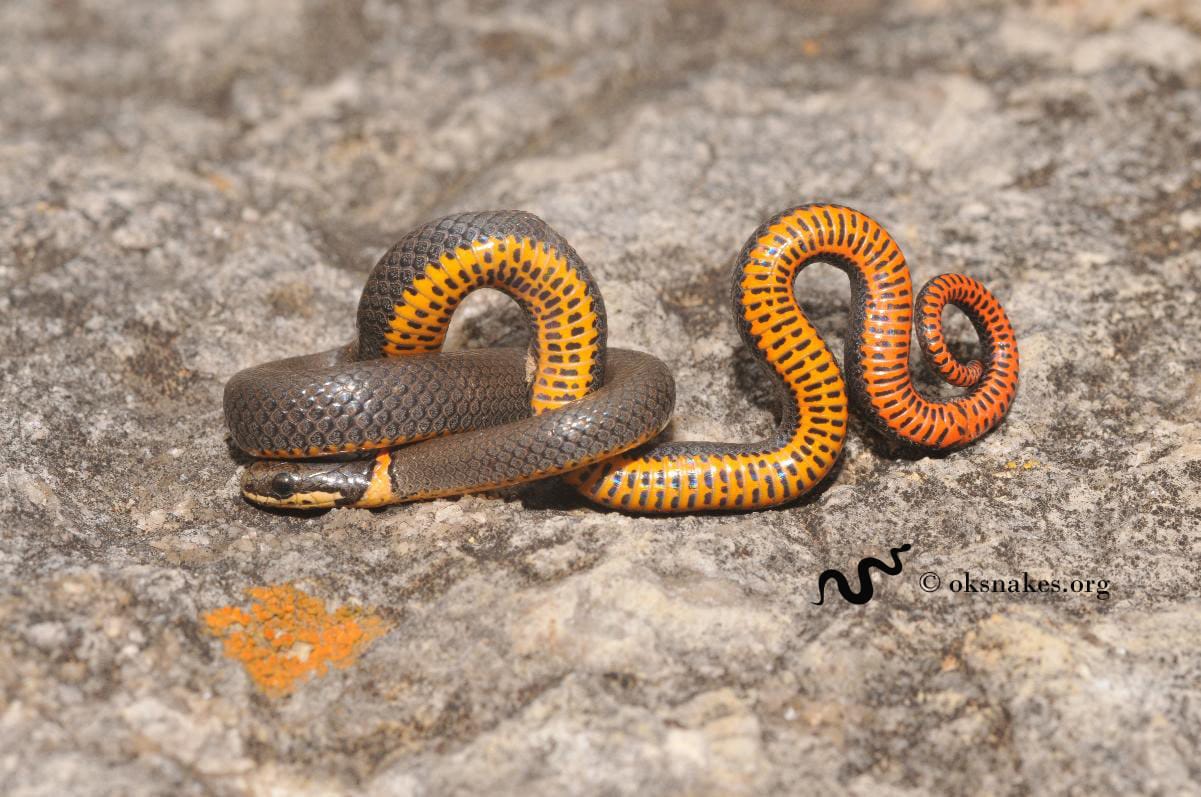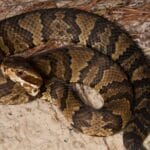Oklahoma, a state renowned for its diverse wildlife, harbors a fascinating yet often misunderstood group of reptiles: venomous snakes. While their presence may evoke caution, these snakes play an integral role in the ecosystem. This comprehensive guide explores the seven venomous snake species found in Oklahoma, providing crucial information on identification, habitats, safety precautions, and first-aid measures. Understanding these remarkable creatures is key to both appreciating their ecological significance and ensuring safe coexistence.
Recognizing Oklahoma’s Venomous Species
Pit Vipers: Nature’s Infrared Hunters
Oklahoma is home to several species of pit vipers, a group characterized by heat-sensing pits located between their eyes and nostrils. These pits allow them to detect warm-blooded prey even in darkness. Pit vipers also share features like triangular heads, vertical pupils, and retractable fangs.
Copperheads (Agkistrodon contortrix and Agkistrodon laticinctus): Two copperhead species reside in Oklahoma: the Eastern Copperhead (Agkistrodon contortrix) and the Broad-banded Copperhead (Agkistrodon laticinctus). Both exhibit distinctive hourglass or Hershey’s Kiss-shaped markings, but their habitat preferences differ. The Eastern Copperhead tends to favor wooded areas, while the Broad-banded Copperhead is more commonly found in rocky terrain. They typically measure between 20 and 37 inches in length. While their venom can be painful, it is rarely fatal with prompt medical treatment.
Northern Cottonmouth (Agkistrodon piscivorus): Dark, thick-bodied, and semi-aquatic, the Northern Cottonmouth is frequently observed near water bodies. They average 26-35 inches in length and are known to be more defensive than other pit vipers, especially when cornered. A threatened cottonmouth may open its mouth, revealing the stark white interior that gives it its common name. Their bite can be serious, requiring immediate medical attention.
Western Diamond-backed Rattlesnake (Crotalus atrox): This large rattlesnake, often exceeding four feet in length, possesses a striking diamond pattern along its back. It favors dry, rocky habitats and is known for its potent venom. Encounters with this species should be avoided at all costs.
Timber Rattlesnake (Crotalus horridus): Inhabiting woodlands and rocky terrains, the Timber Rattlesnake is identified by its dark crossbands and a rusty dorsal stripe. Like other rattlesnakes, it often uses its rattle as a warning signal, though maintaining a safe distance is always advised.
Western Massasauga (Sistrurus tergeminus edwardsii): Smaller than other rattlesnake species in Oklahoma, the Western Massasauga displays distinct blotches and prefers grasslands and marshes. Despite its smaller size, its venom should be considered a serious medical concern.
Western Pygmy Rattlesnake (Sistrurus miliarius streckeri): The smallest of Oklahoma’s rattlesnakes, the Western Pygmy Rattlesnake, features nine large scales on the top of its head and is often found near water sources. While its venom is considered less potent than that of larger rattlesnakes, medical attention is still necessary following a bite.
The Elusive Coral Snake
- Texas Coral Snake (Micrurus tener): While considered rare in Oklahoma, the Texas Coral Snake is strikingly beautiful with its vibrant red, yellow, and black bands. These bands serve as a warning, reflected in the rhyme, “Red touch yellow, kill a fellow.” This saying differentiates it from similar-looking, harmless milk snakes (“Red touch black, friend of Jack”). While highly venomous, coral snakes are secretive, and bites are extremely rare. Their fixed fangs and neurotoxic venom differentiate them from the pit vipers.
Venomous vs. Non-Venomous: A Critical Distinction
Distinguishing between venomous and non-venomous snakes is a crucial skill for anyone spending time outdoors in Oklahoma. While pit vipers exhibit characteristic triangular heads, vertical pupils, and heat-sensing pits, some non-venomous snakes may exhibit similar features when threatened. Coral snakes have rounded heads, round pupils, and fixed fangs. Many non-venomous snakes have rounded heads and round pupils. However, relying solely on these features can be misleading. Consulting a reliable field guide, like the “Peterson Field Guide to Reptiles and Amphibians,” or seeking expert advice is always recommended. If you’re unsure, it’s always best to err on the side of caution and treat any snake you encounter with respect.
Snakebite First Aid and Safety
First Aid: Act Quickly and Calmly
In the event of a venomous snakebite, maintaining composure and taking swift action are crucial.
- Immediate Medical Attention: Call 911 or seek immediate medical assistance at the nearest hospital. Time is of the essence.
- Description: If possible, provide a description of the snake’s appearance to medical professionals, aiding in identification and treatment.
- Immobilization: Keep the bitten area immobilized and, if possible, positioned below heart level.
- Avoid Harmful Actions: Do not apply a tourniquet, ice, or attempt to cut or suck the venom. These actions can worsen the injury.
Prevention: Minimizing the Risk of Encounters
Reducing the likelihood of snake encounters involves awareness and respect for their habitat.
- Appropriate Attire: When hiking or working outdoors, wear sturdy boots and long pants.
- Cautious Exploration: Exercise caution when reaching into woodpiles, under rocks, or other potential hiding places.
- Yard Maintenance: Keep yards clear of debris and overgrown vegetation, which can attract rodents and, subsequently, snakes.
- Respectful Distance: If you encounter a snake, maintain a safe distance and allow it to retreat on its own. Remember, most snakes prefer to avoid humans.
Ecological Importance and Conservation
Venomous snakes, despite the fear they sometimes inspire, are vital components of the Oklahoma ecosystem. They act as natural pest control, regulating rodent populations that can carry diseases and damage crops. By contributing to a balanced ecosystem, these snakes support the health and stability of the environment. Ongoing research continues to reveal the complexities of their ecological roles and the potential medical applications of their venom.
Debunking Myths: Separating Fact from Fiction
Misconceptions about venomous snakes often stem from fear and misinformation. Snakes are not inherently aggressive and typically bite only when they feel threatened. They do not chase people or actively seek out opportunities to bite. Continued education and research are essential to dispelling these myths and fostering a greater appreciation for these often-maligned creatures.
Exploring Further: Additional Resources and Insights
For more in-depth information, consider exploring the following resources:
- Oklahoma Department of Wildlife Conservation: [Insert Link Here]
- Oklahoma Center for Poison and Drug Information: [Insert Link Here]
You can also delve deeper into the world of venomous creatures by learning about the venomous spiders in Texas or understanding the behavior of semi-aquatic rodents like muskrats.
This exploration of Oklahoma’s venomous snakes emphasizes the importance of informed coexistence. By recognizing their unique characteristics, understanding their ecological roles, and employing sensible safety precautions, we can appreciate these fascinating reptiles while ensuring both human and environmental well-being.
- Unlocking Francis Alexander Shields’ Finance Empire: A Comprehensive Biography - July 12, 2025
- Unveiling Francis Alexander Shields: A Business Legacy - July 12, 2025
- Francis Alexander Shields’ Business Career: A Comprehensive Overview - July 12, 2025















